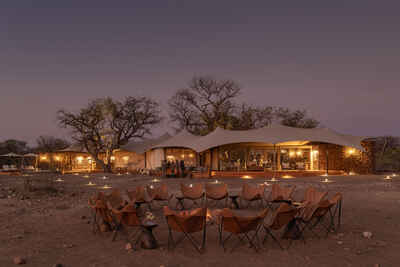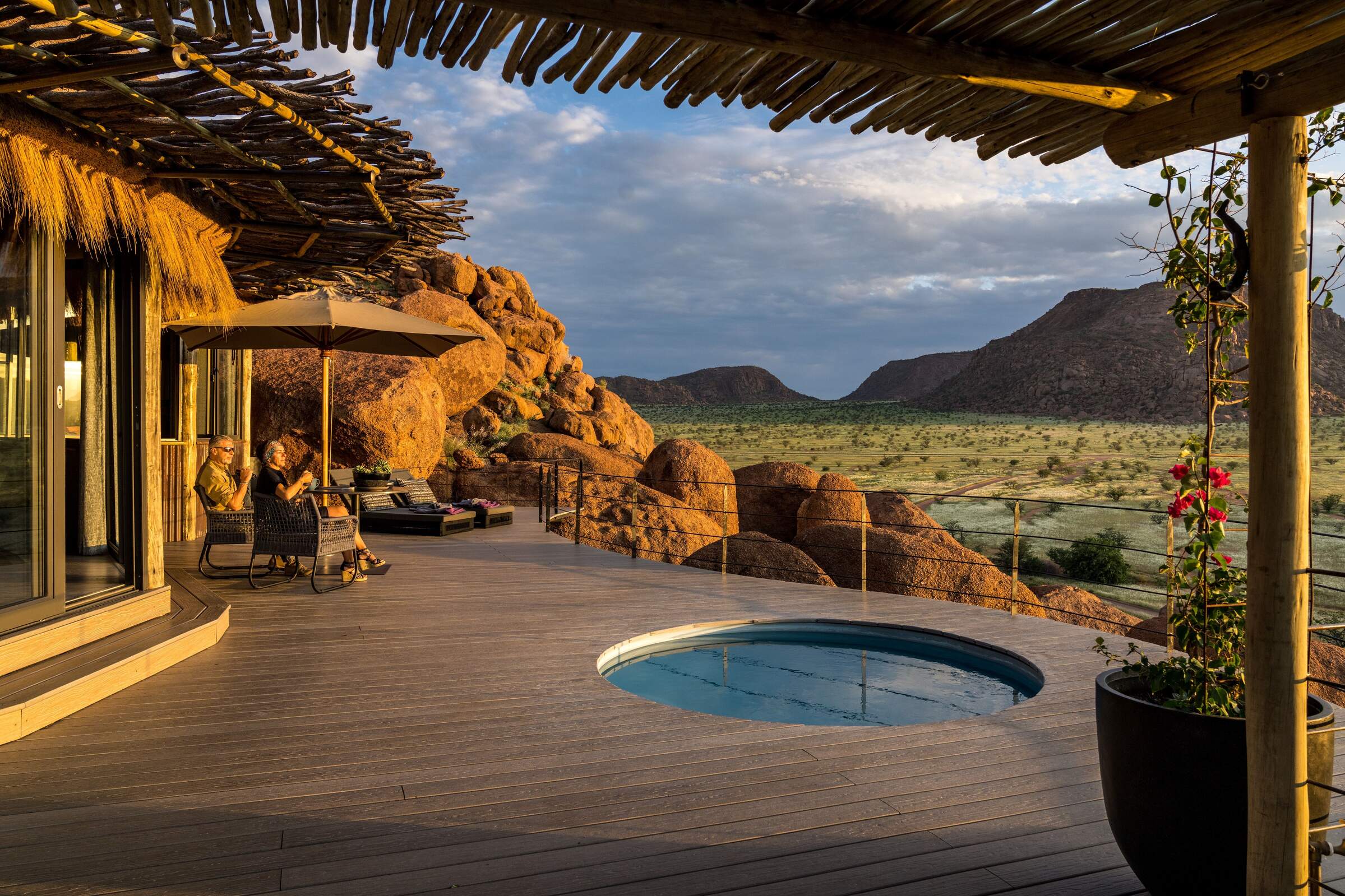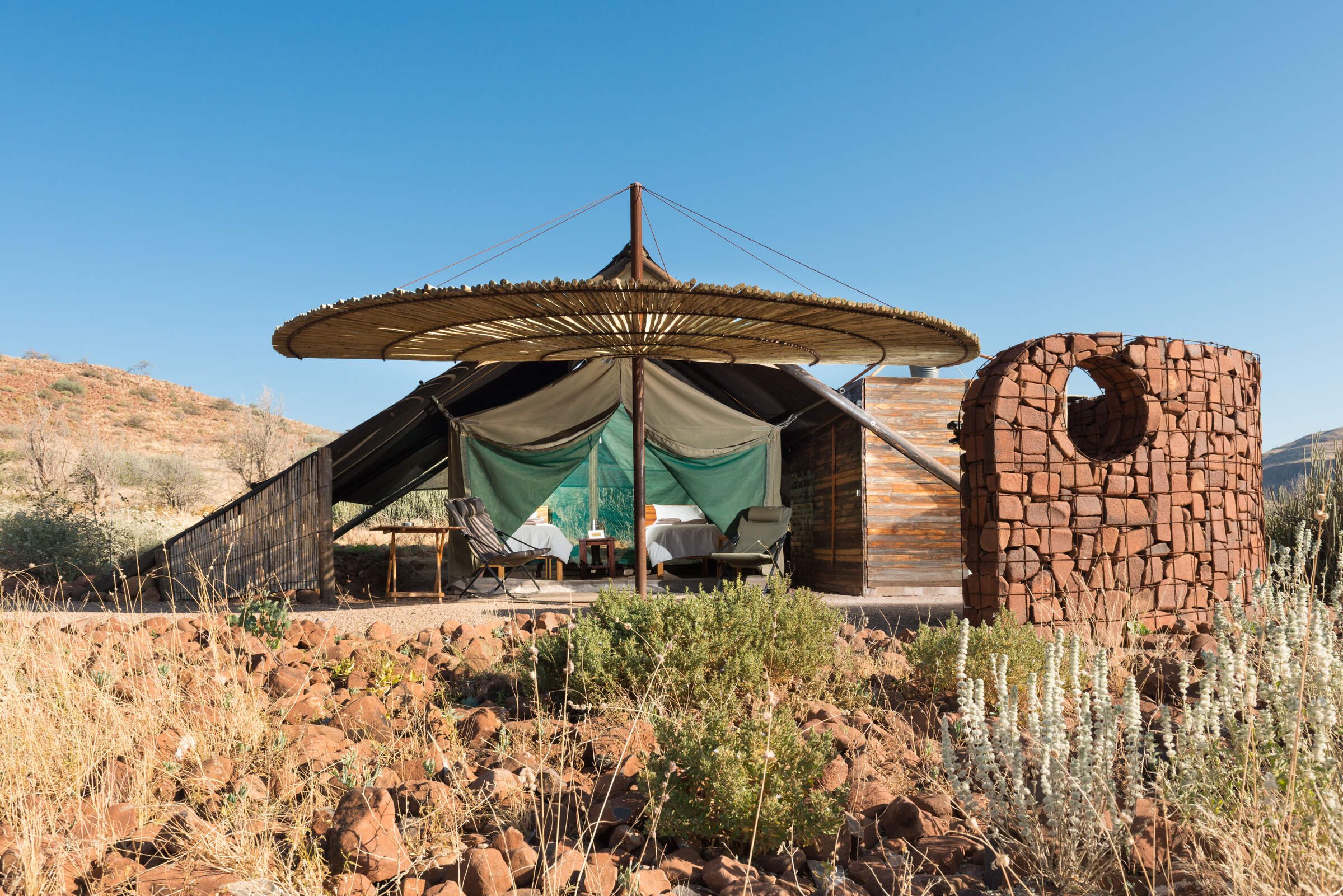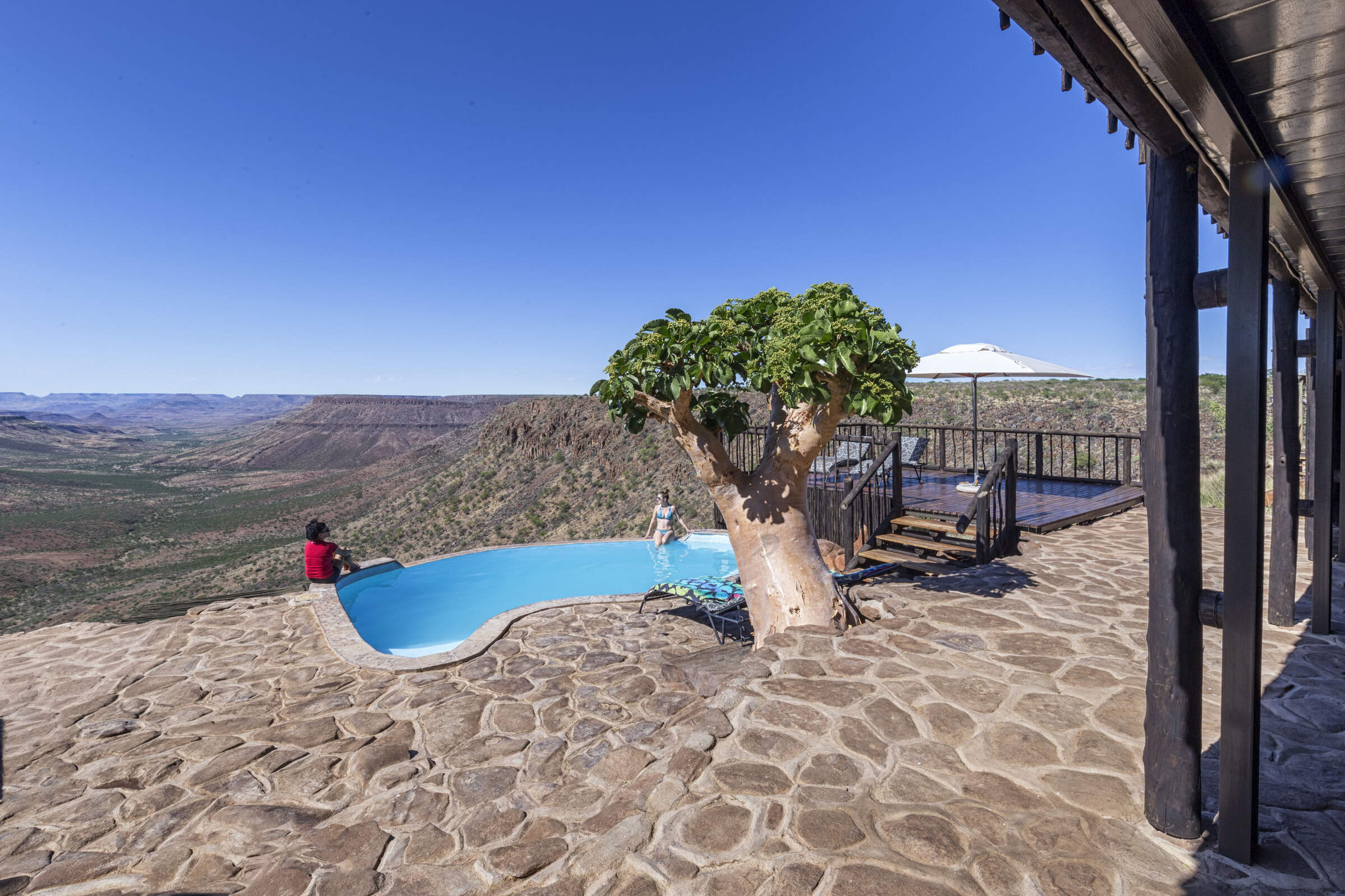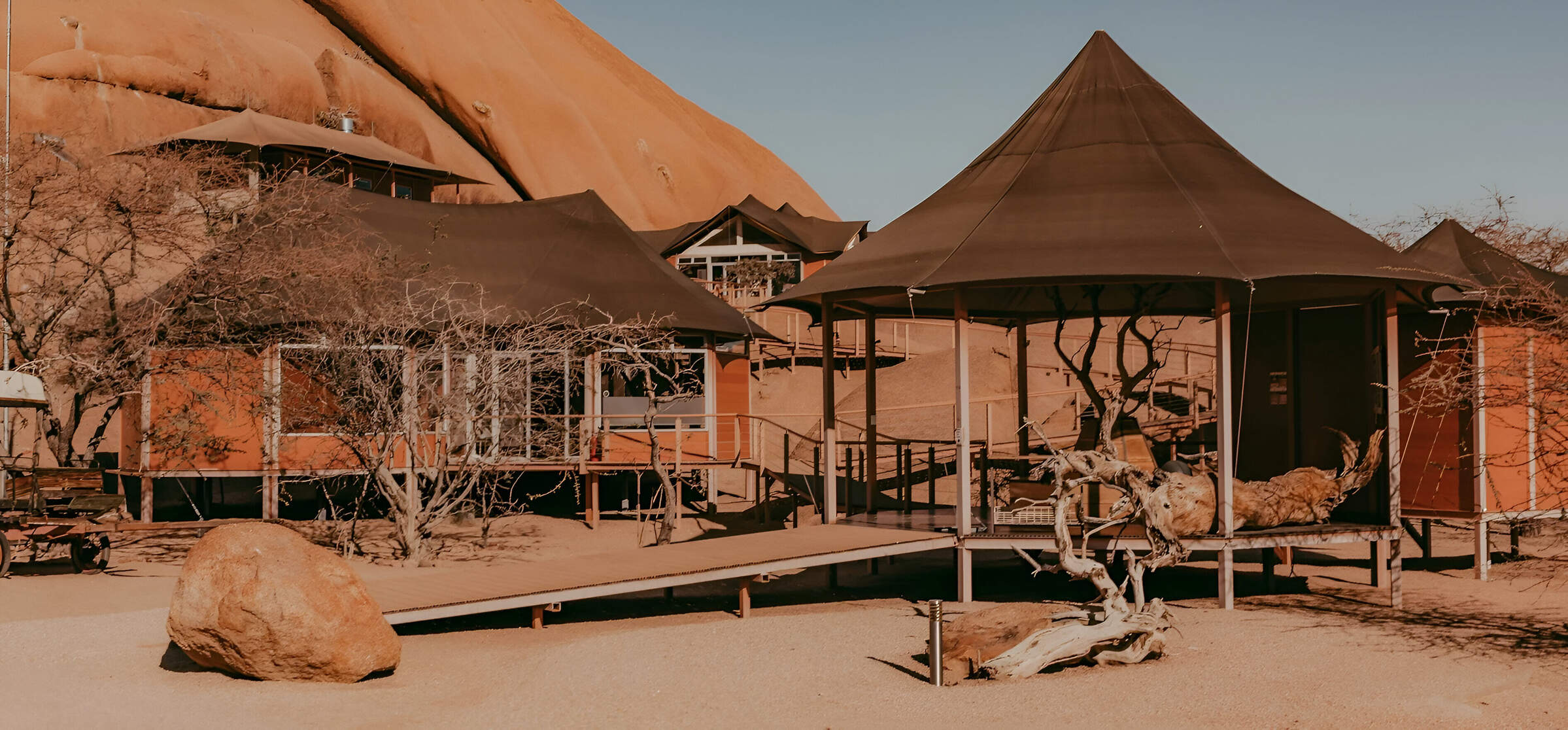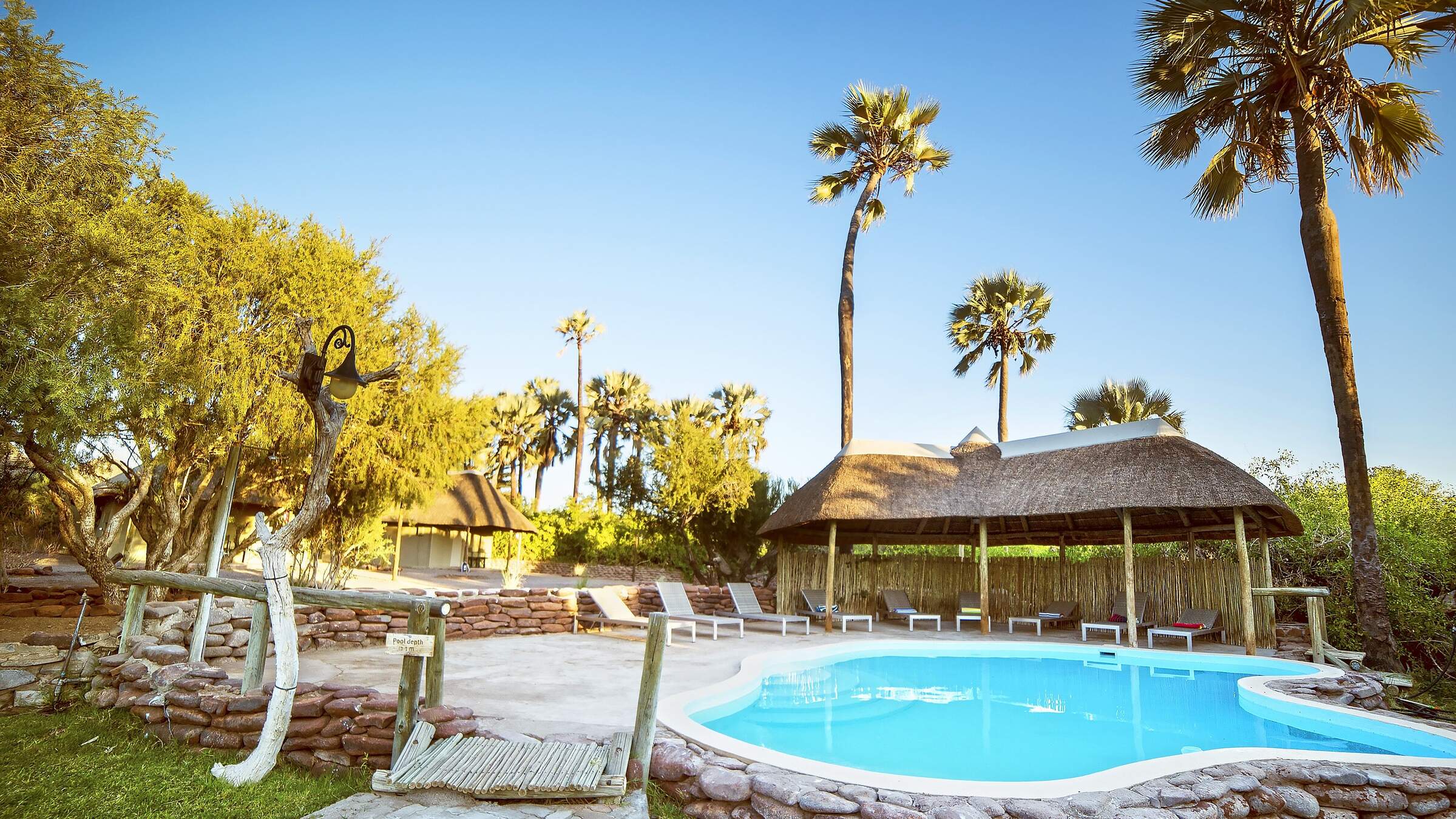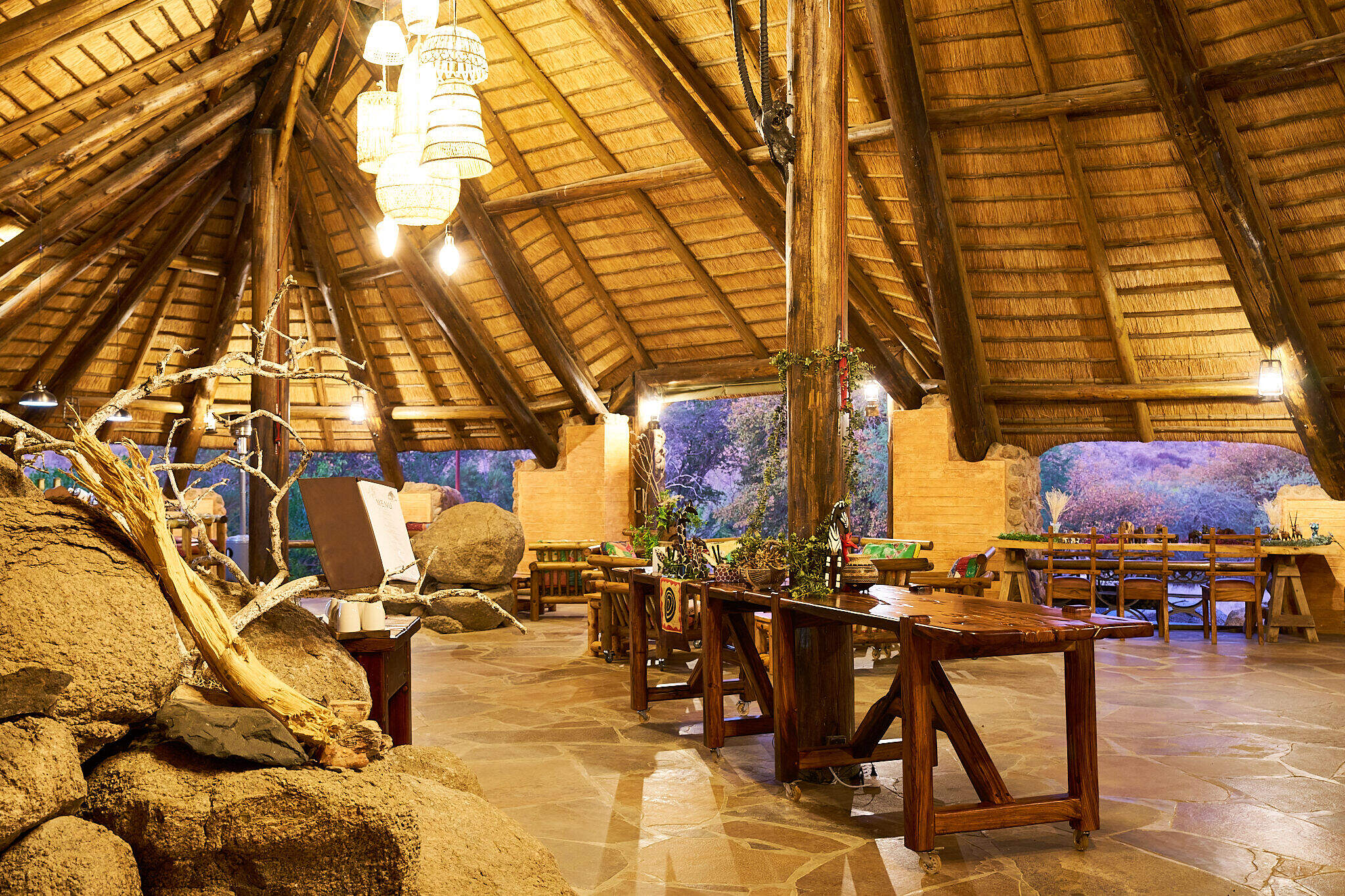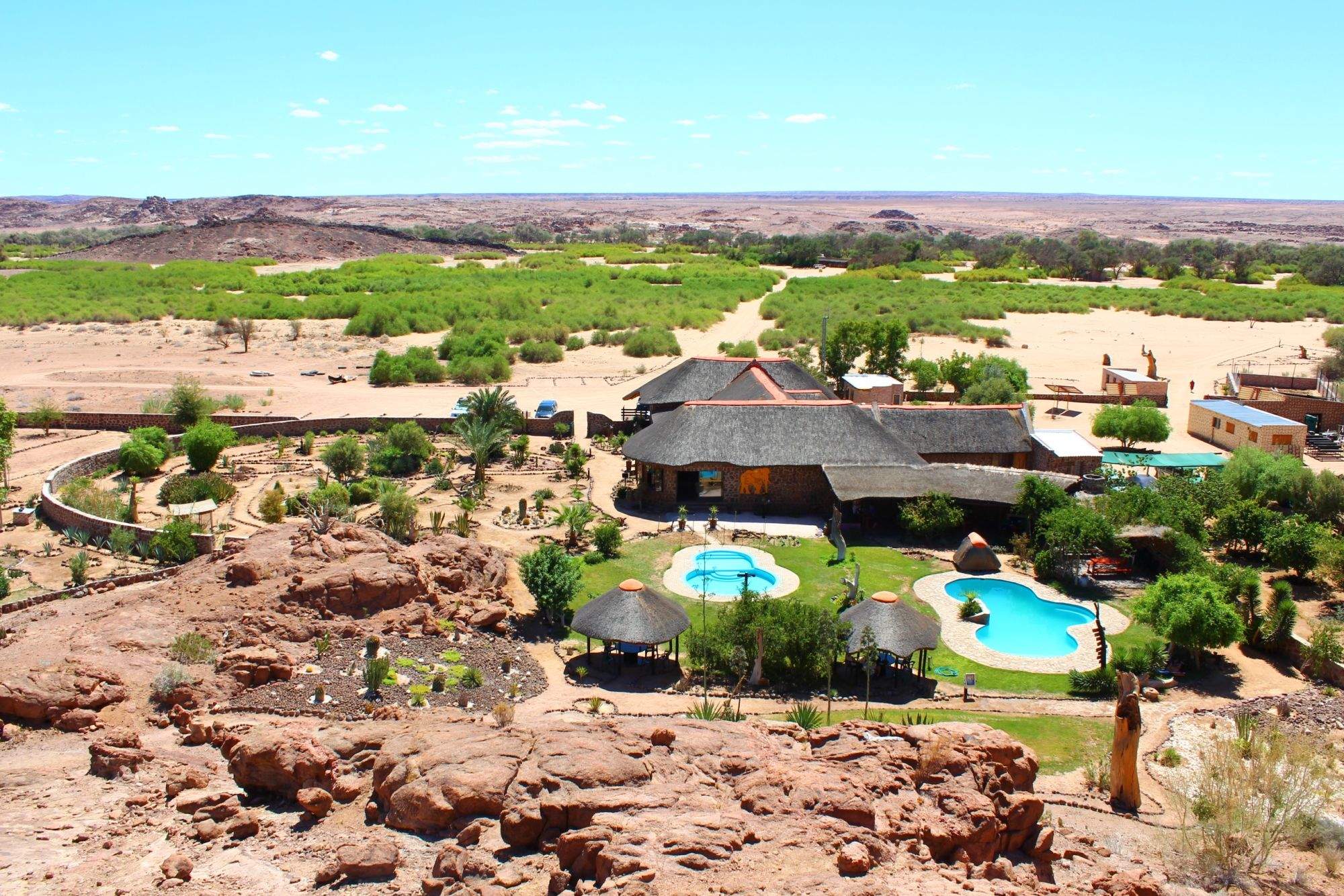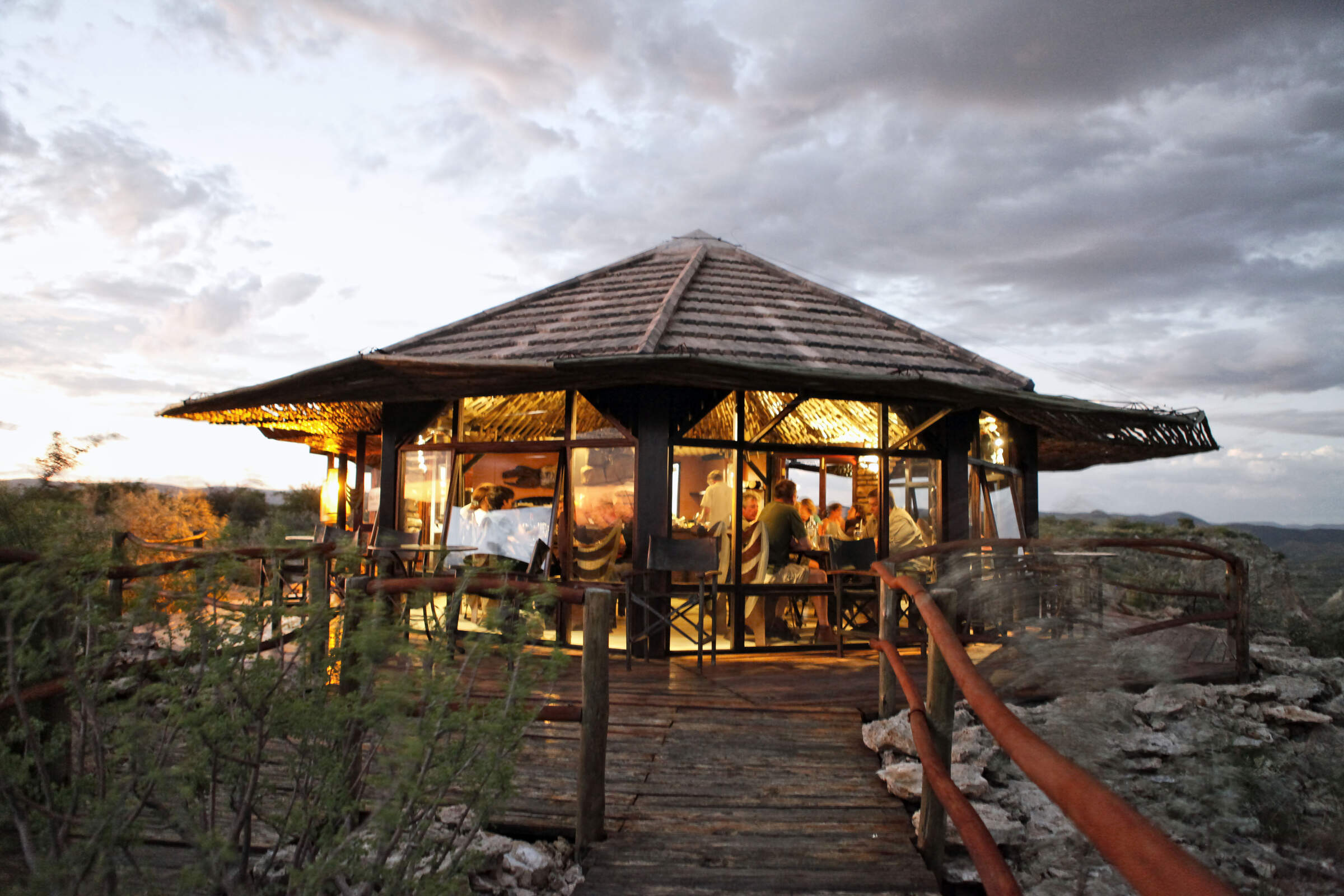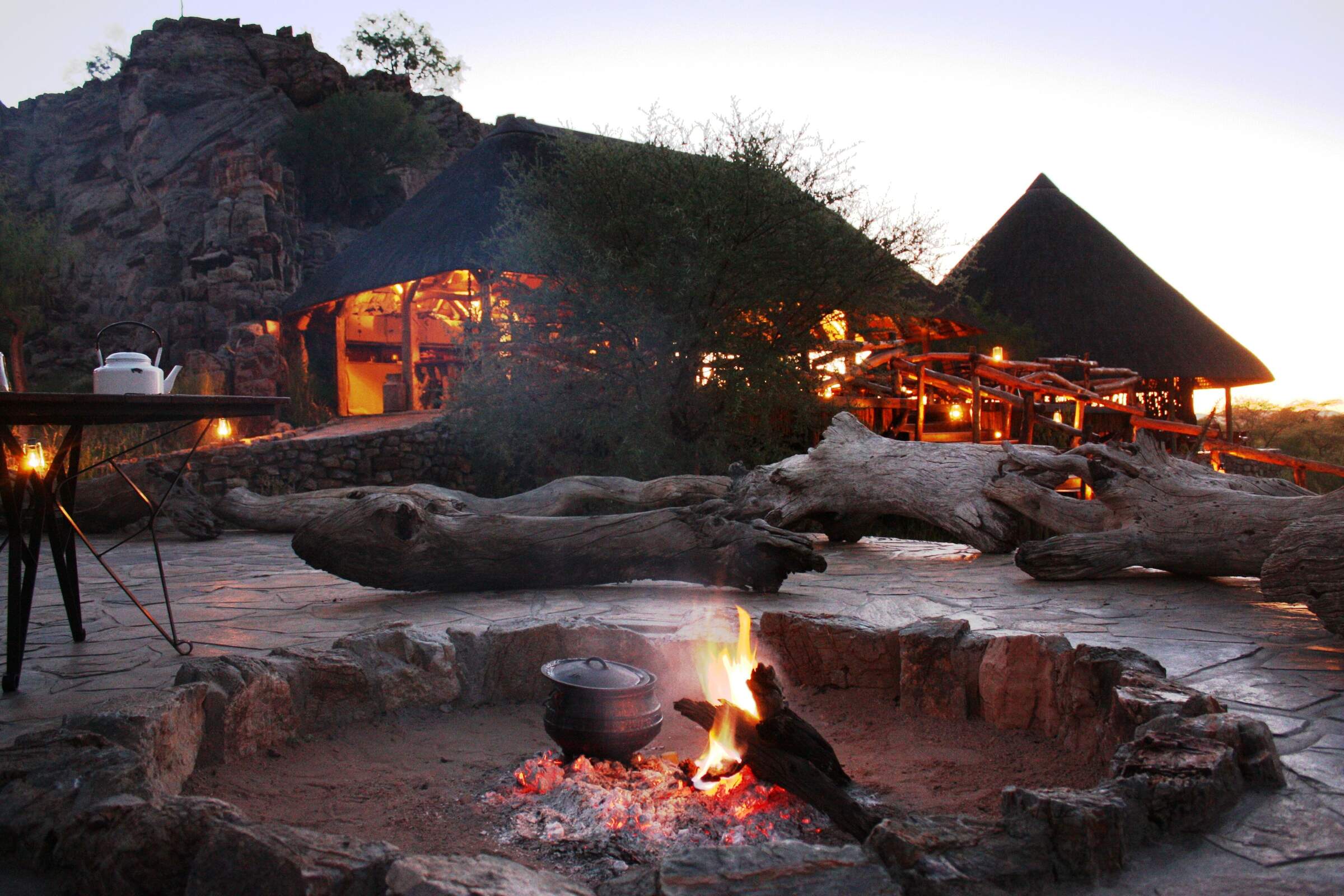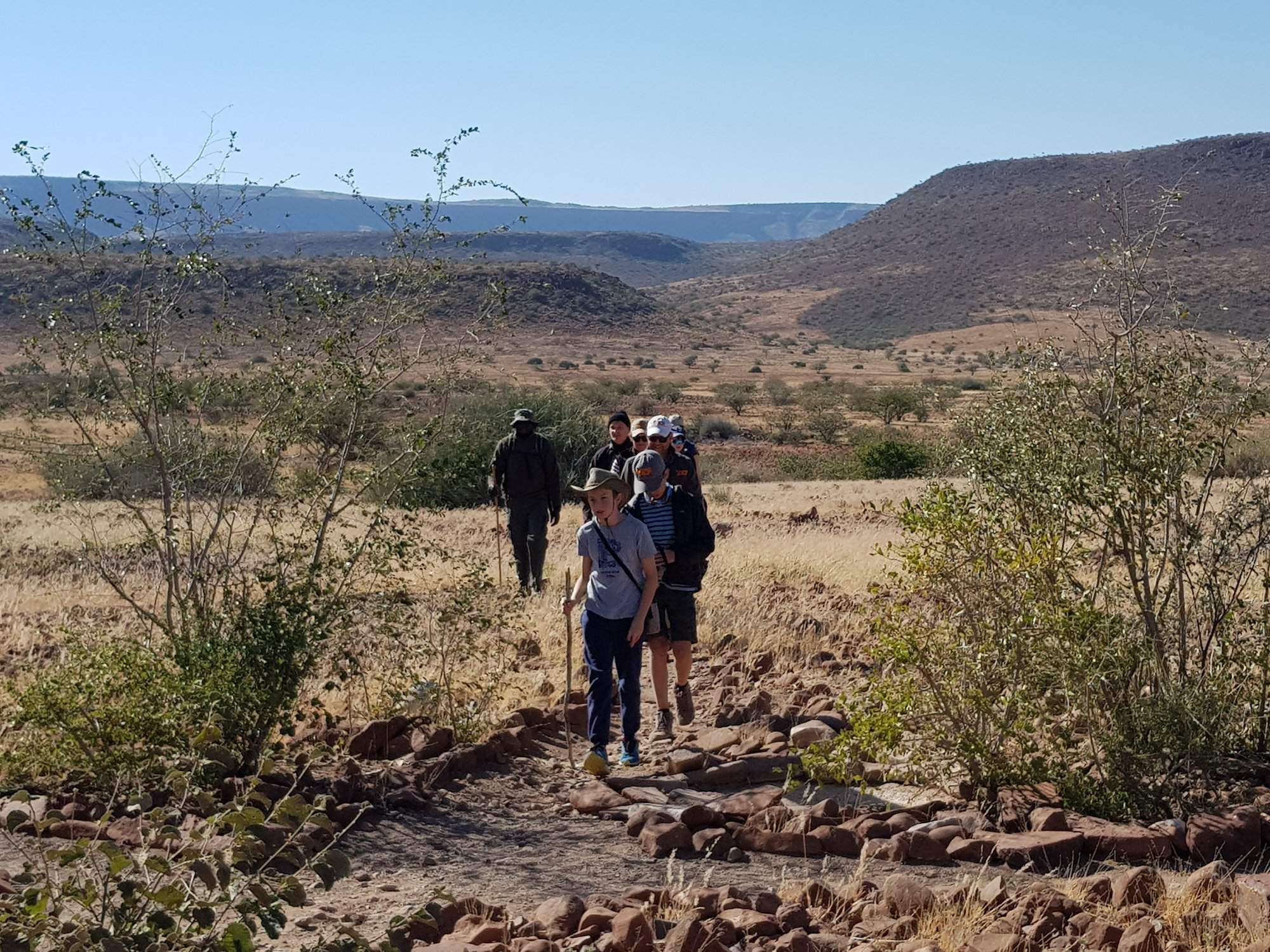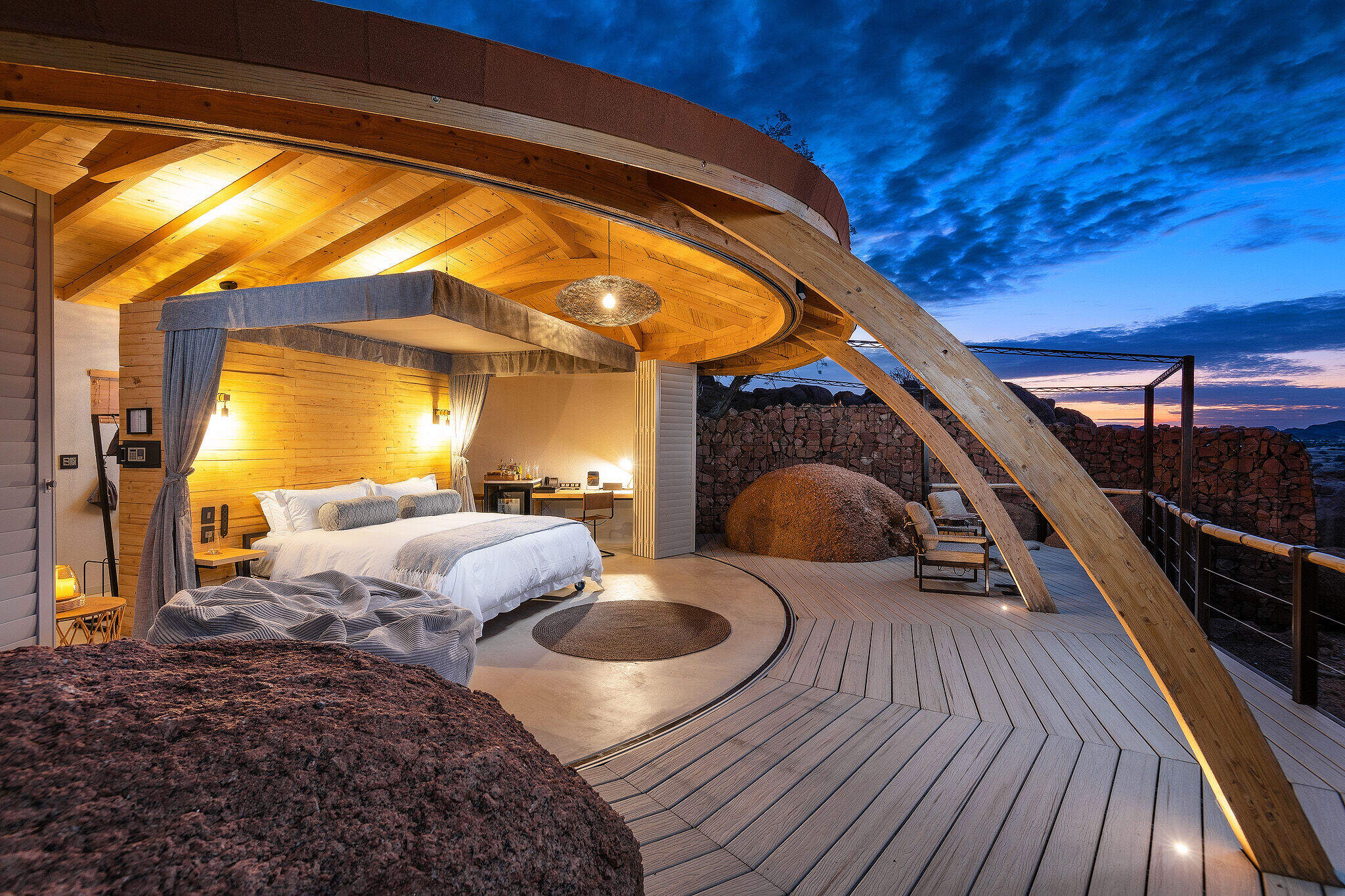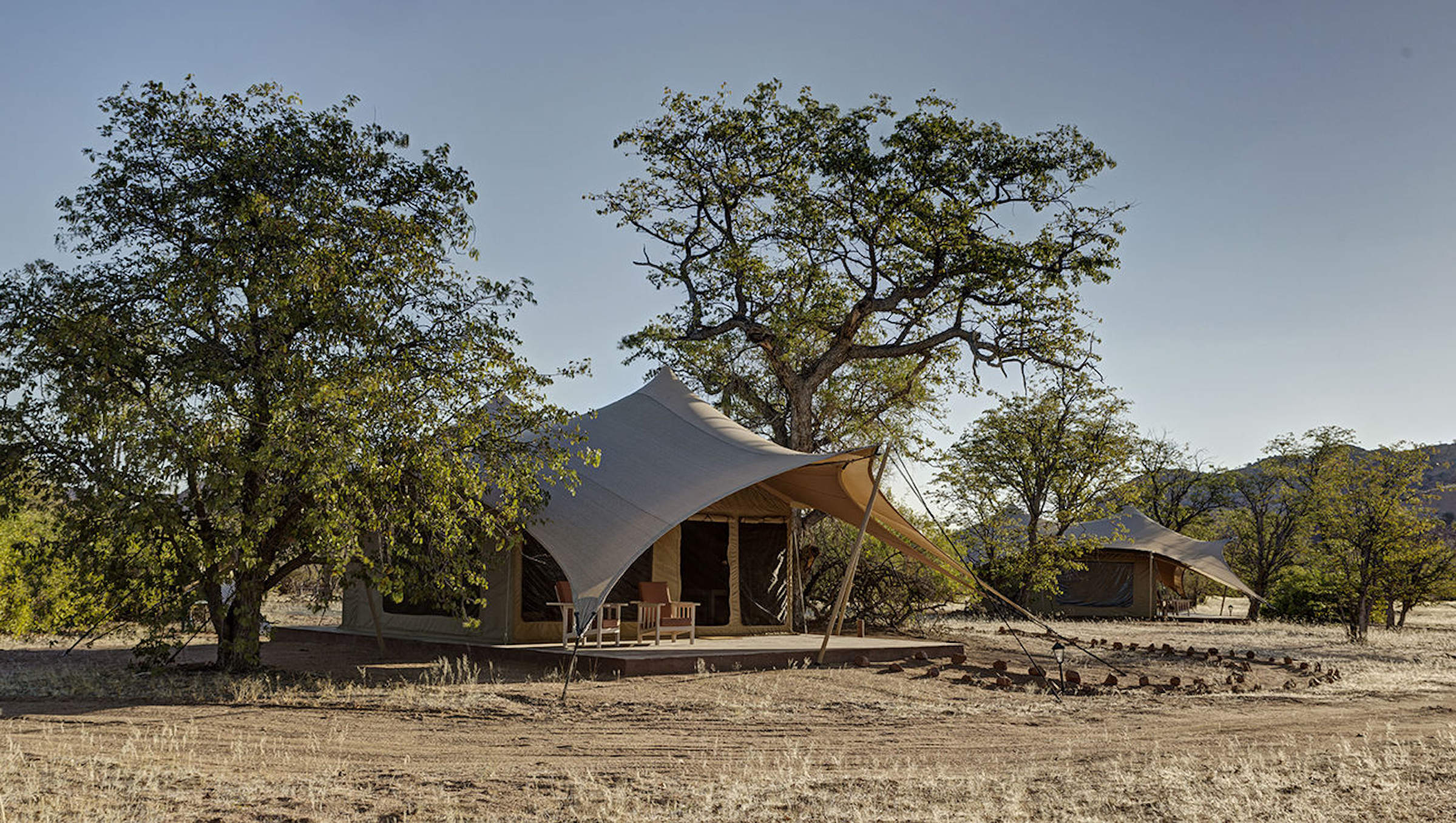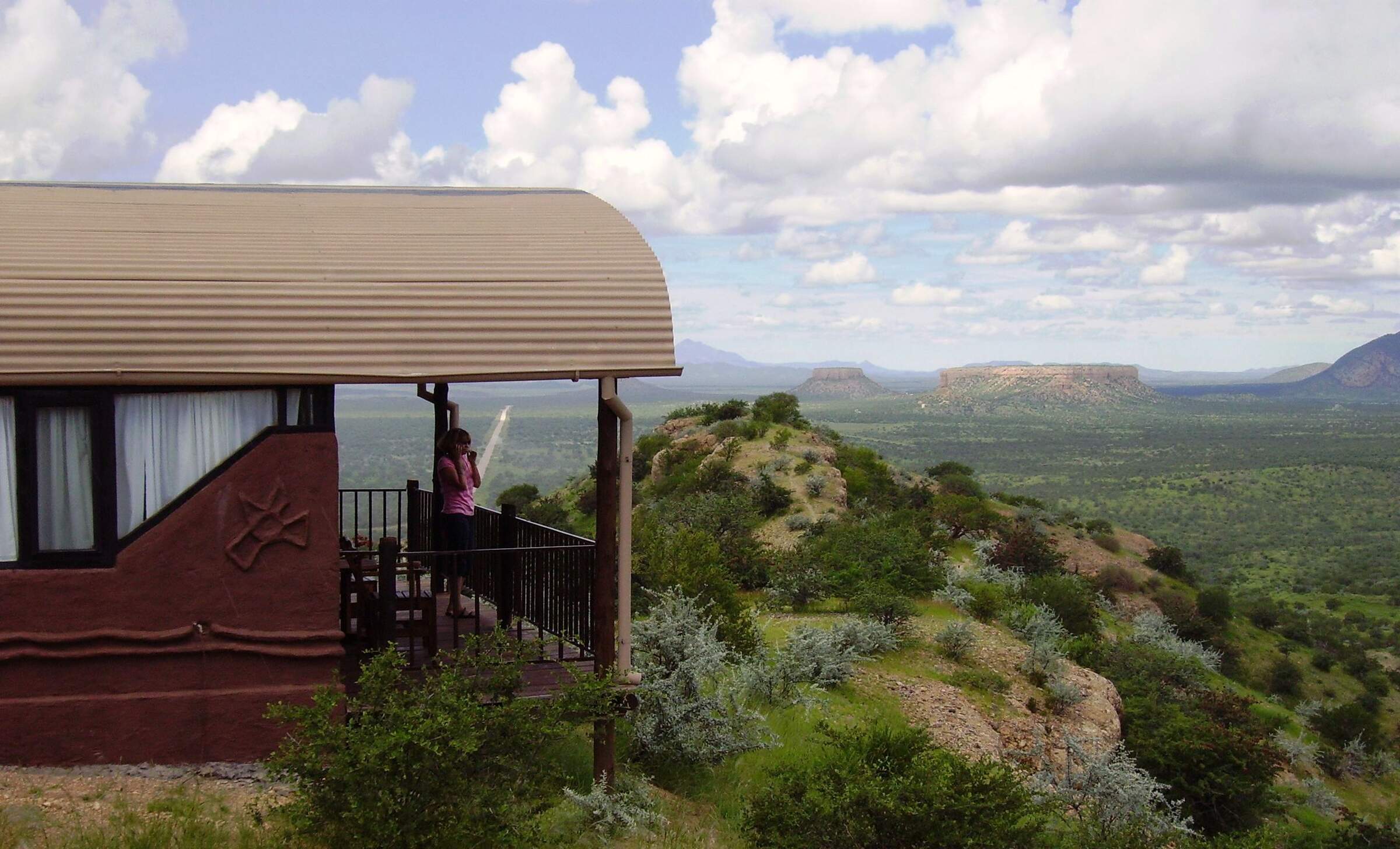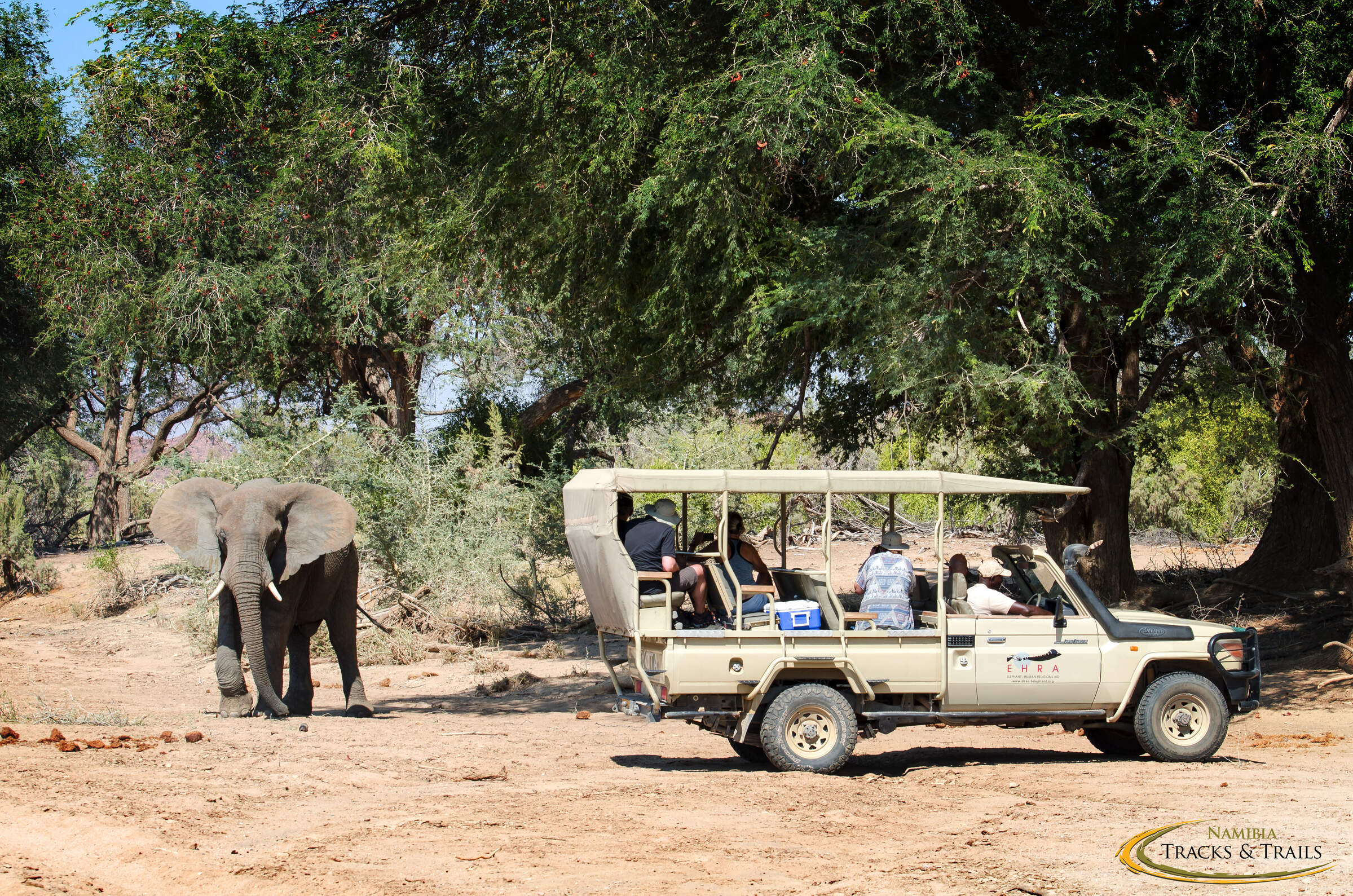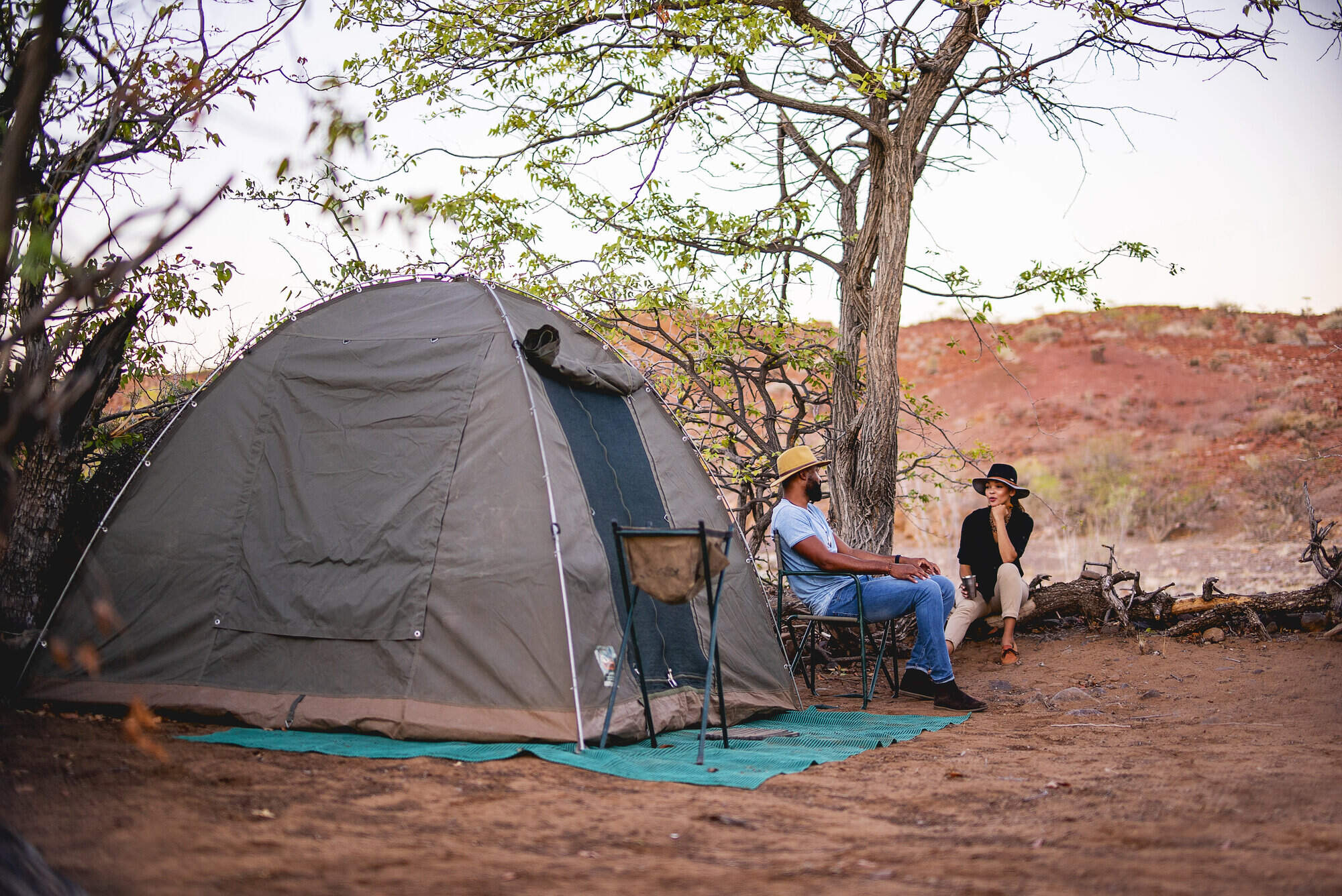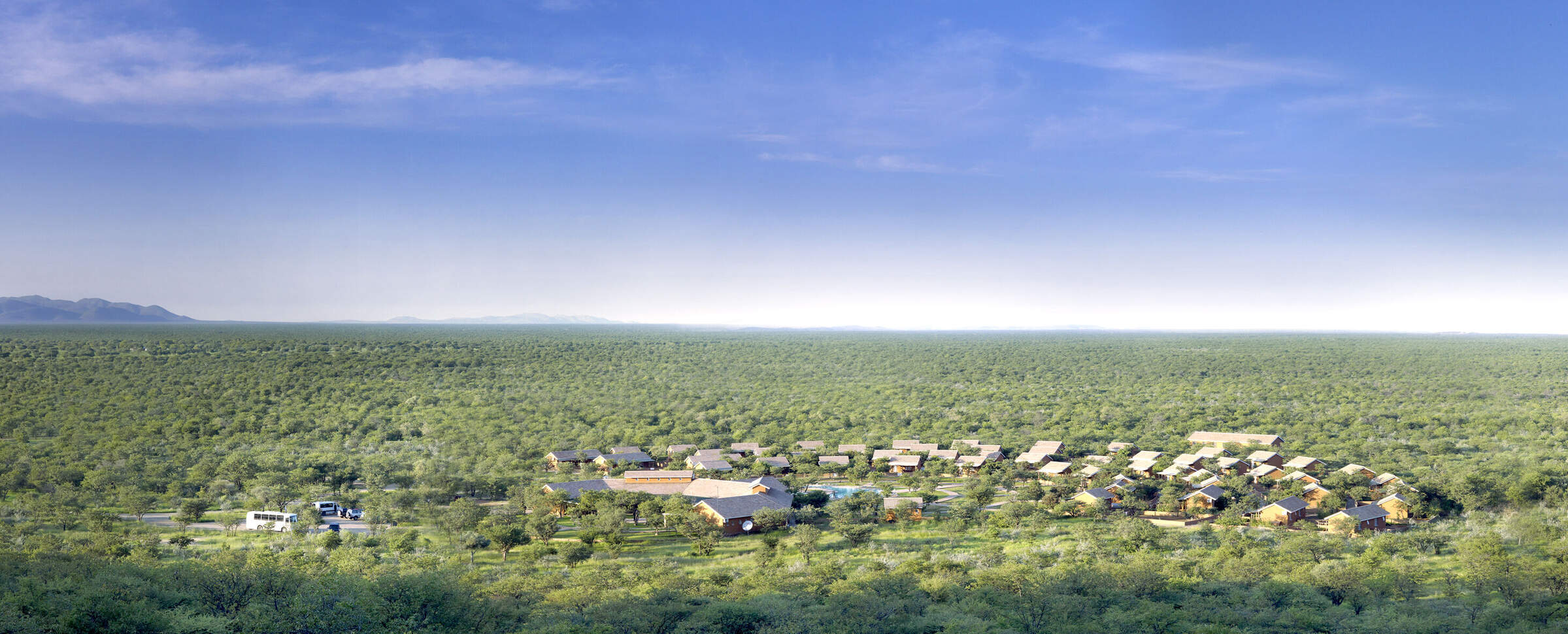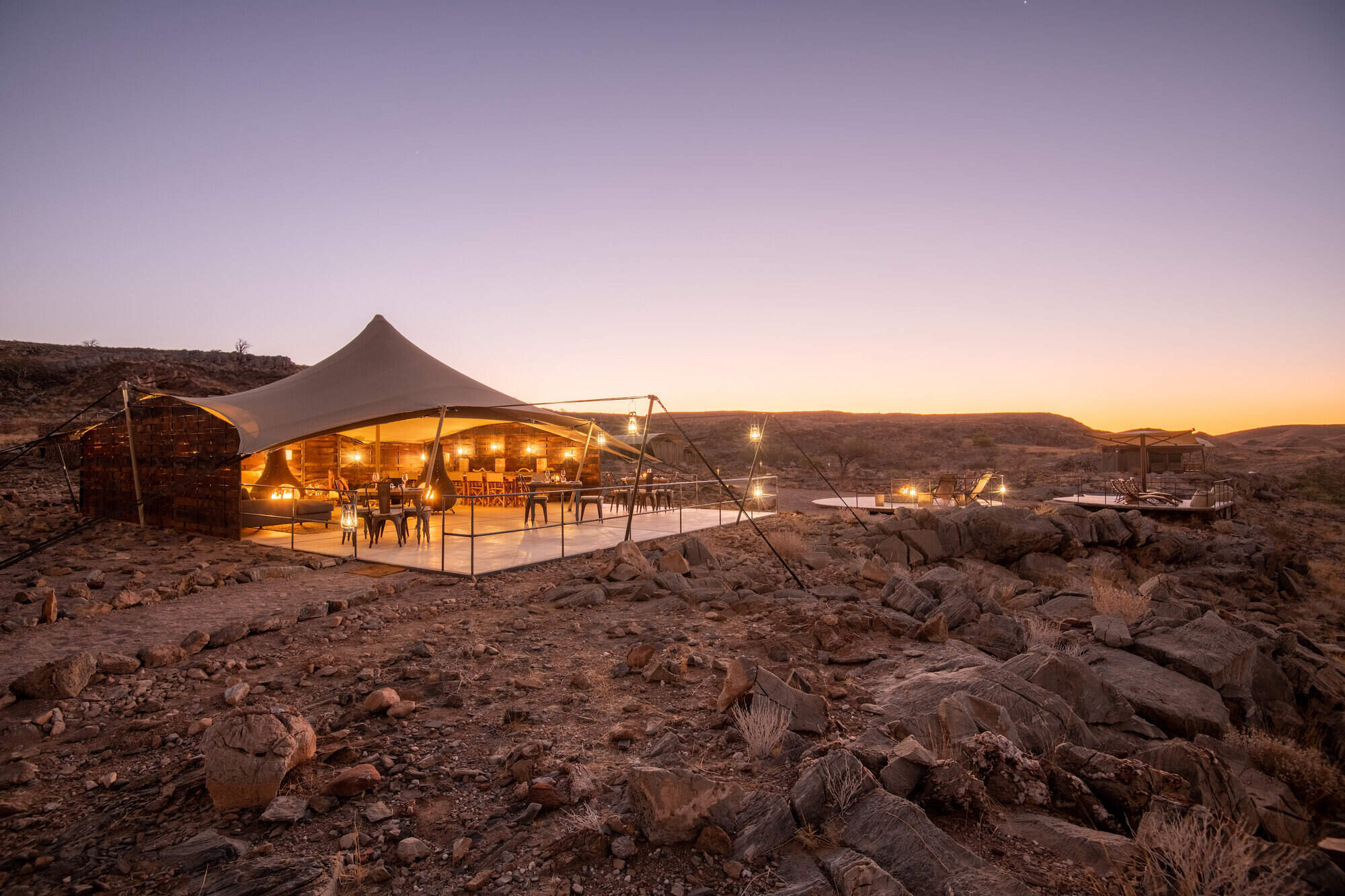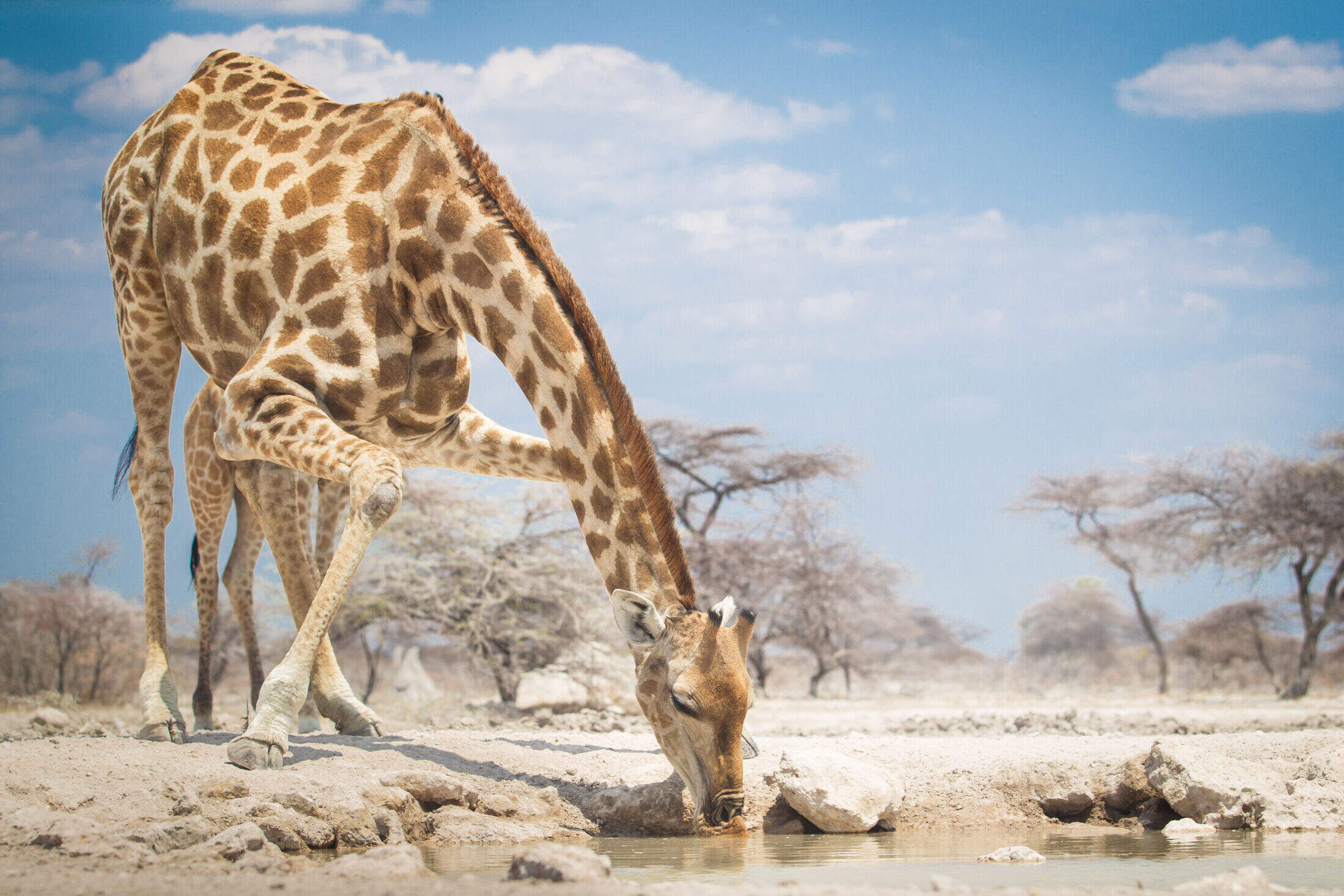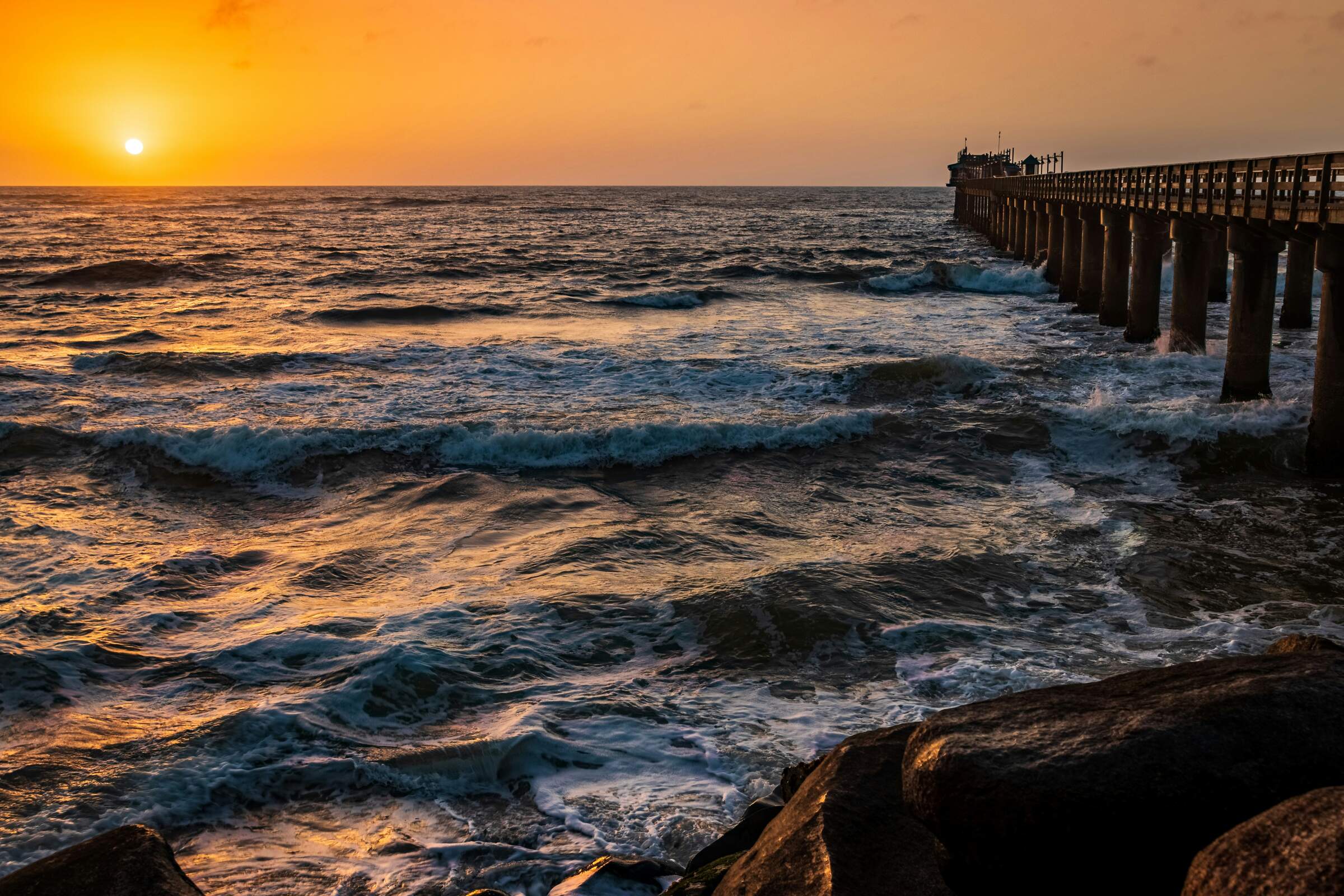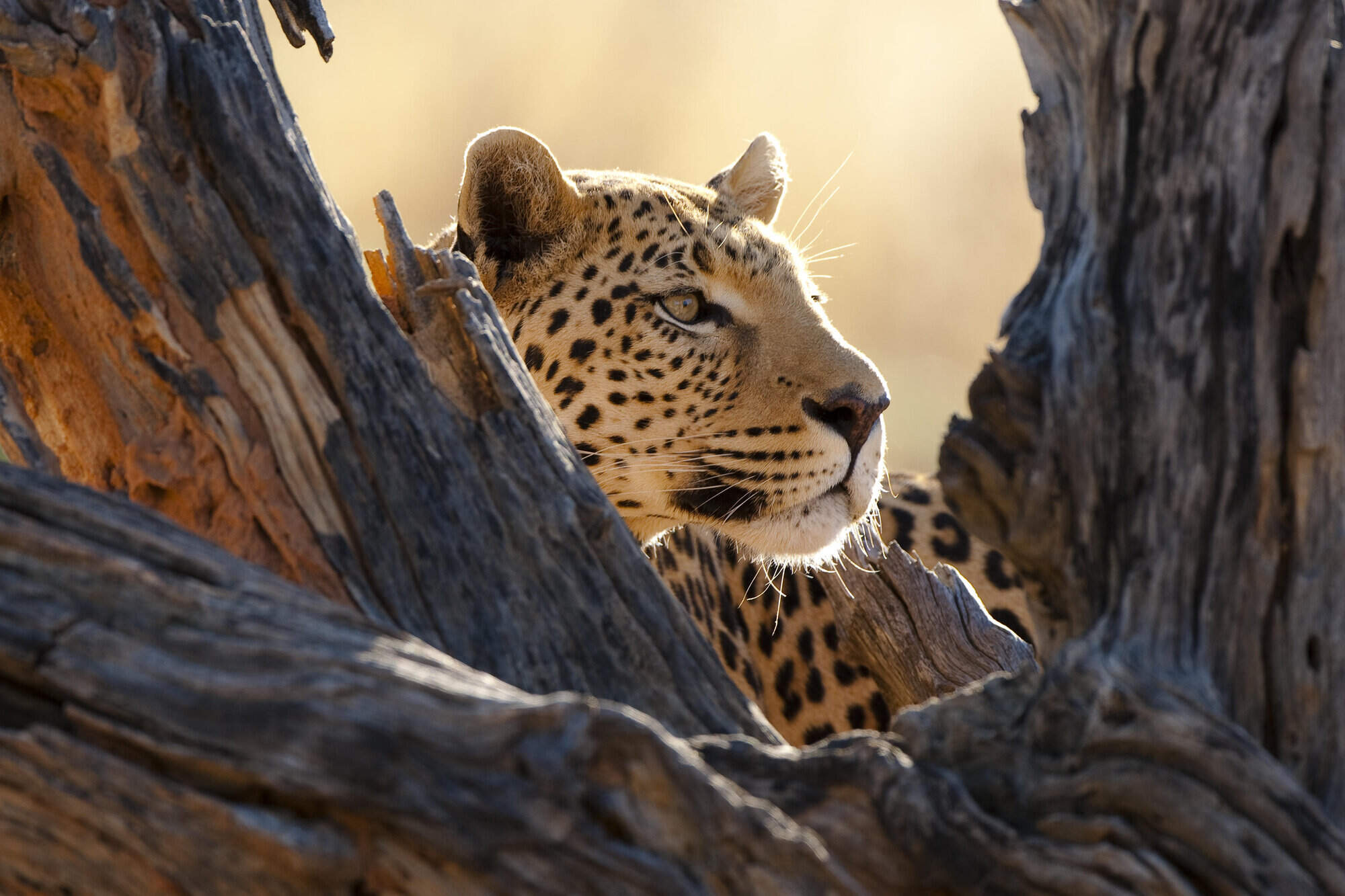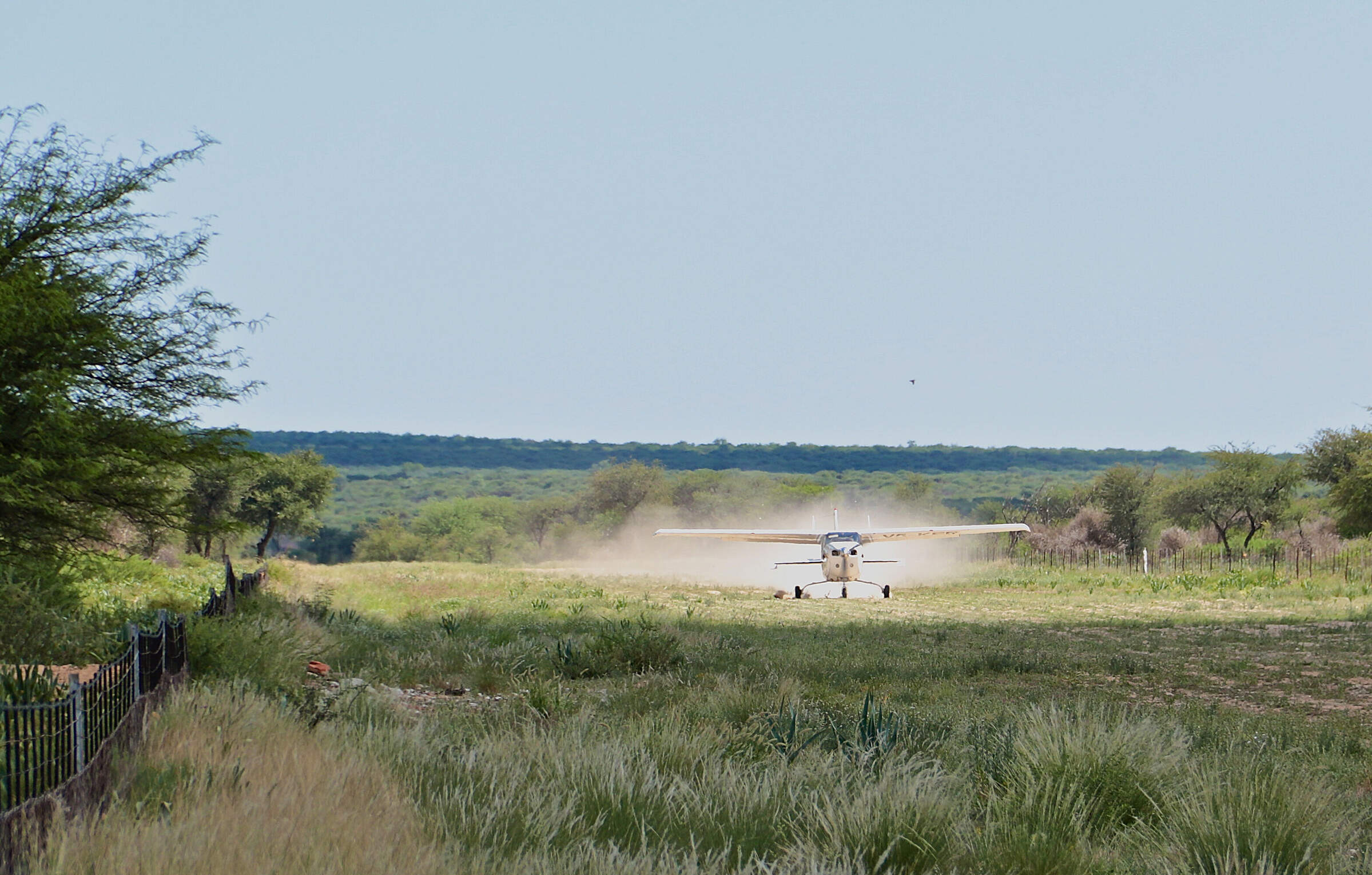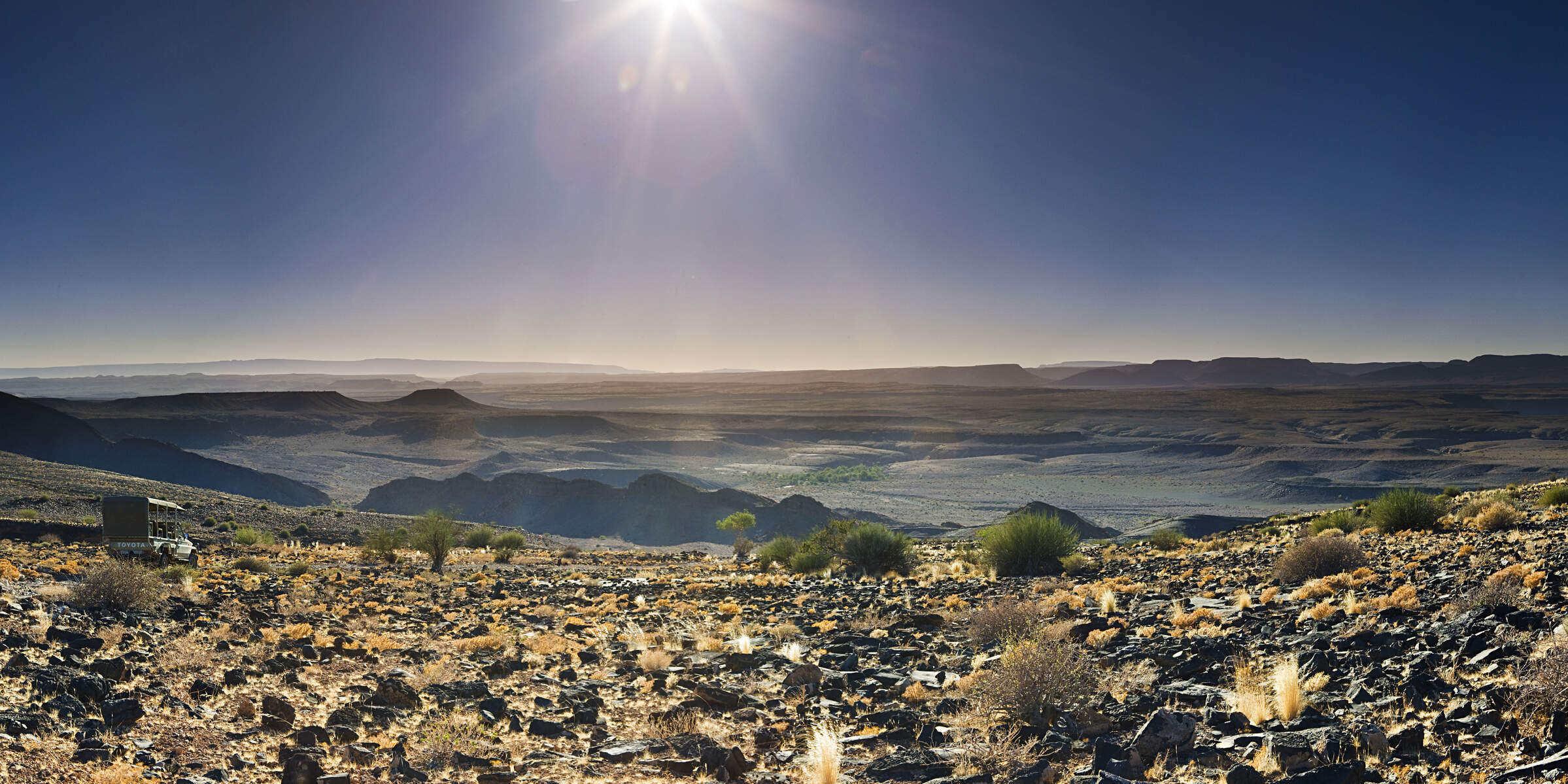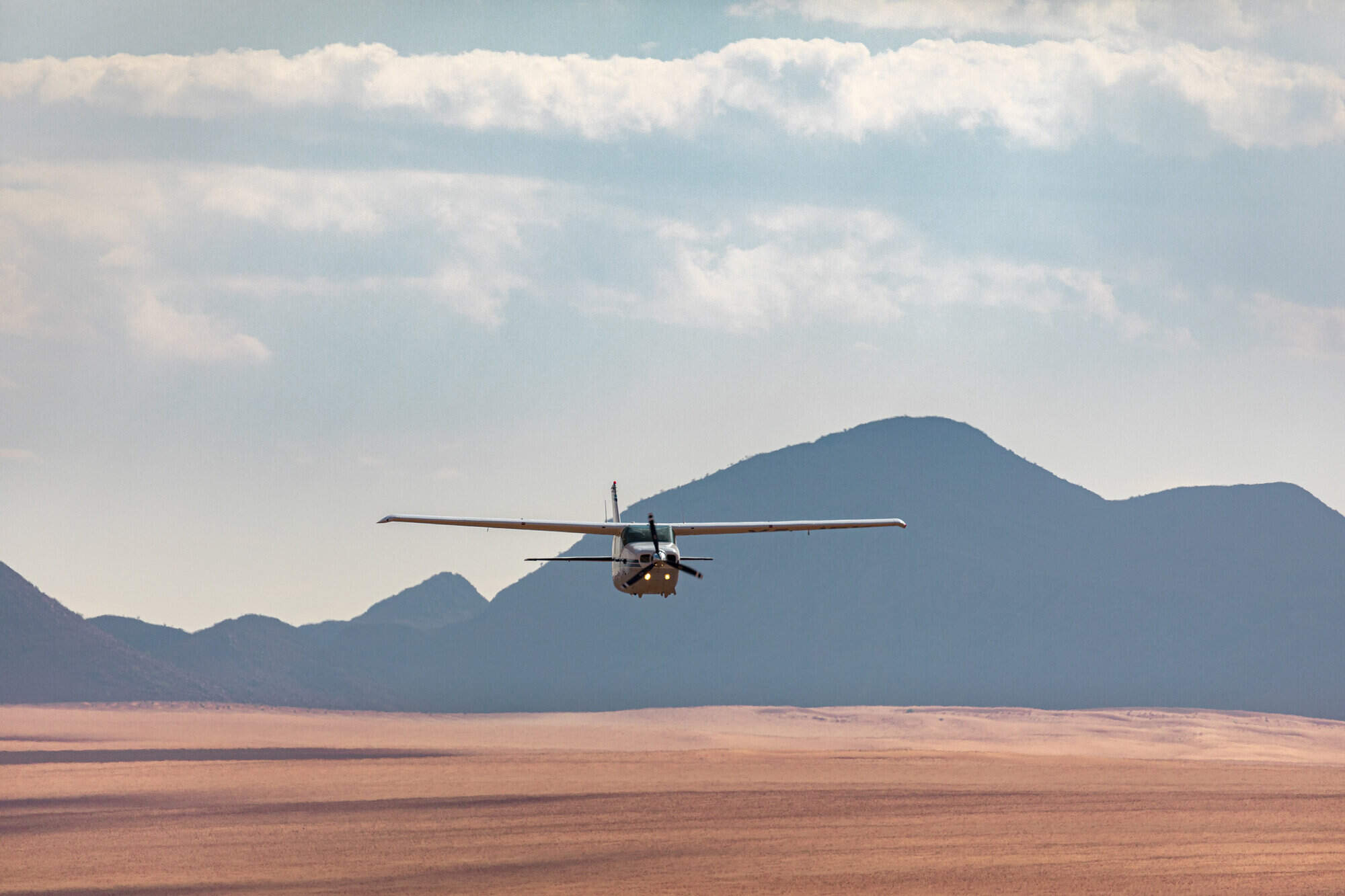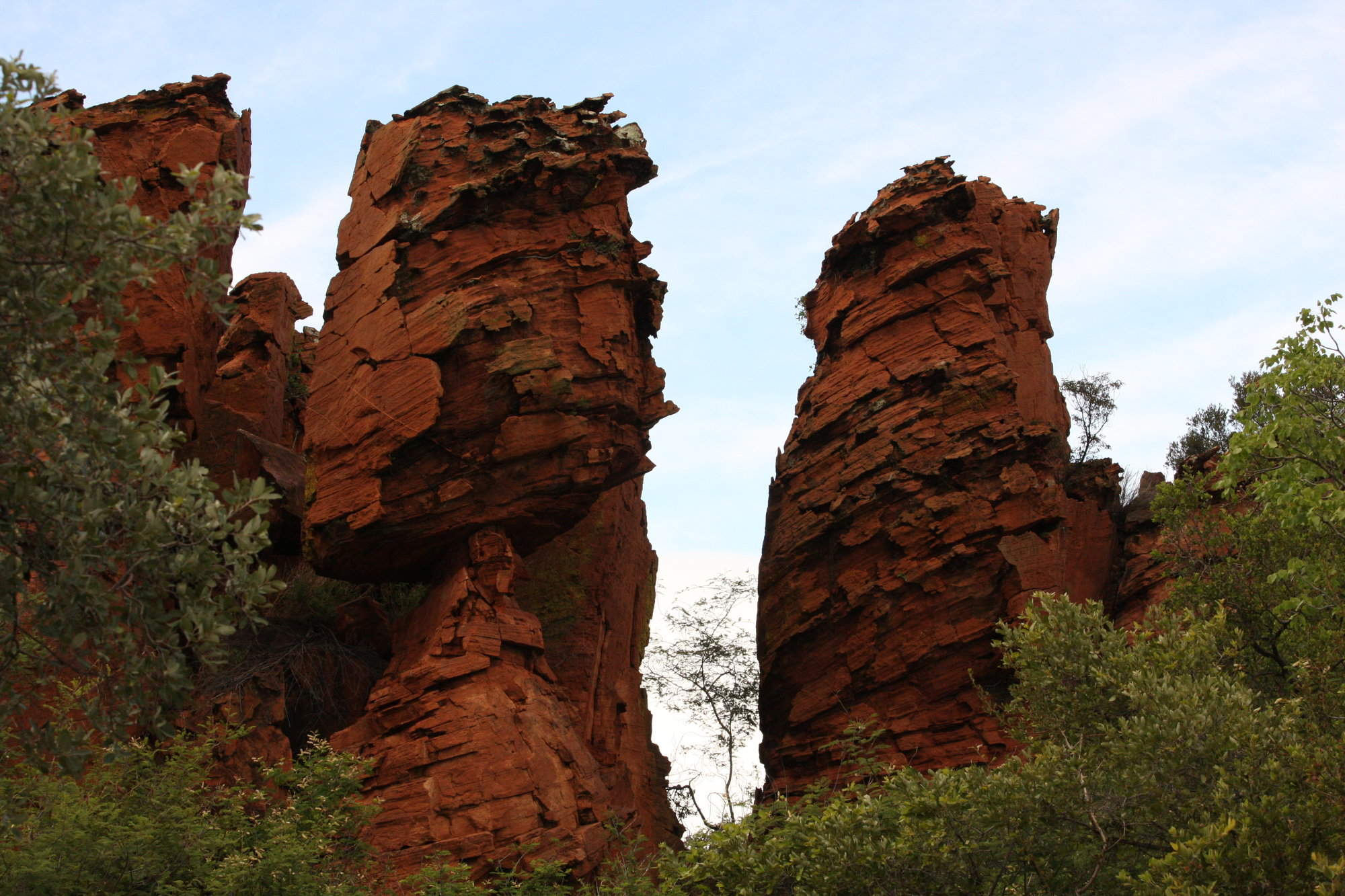Desert Rhino Camp: Our full report
Remote, exclusive and specialised, Desert Rhino Camp lies in the vast Palmwag Concession.
This semi-desert reserve of about 5,000km² between Etosha National Park and the Skeleton Coast is one of the best places to see desert-dwelling black rhino and other desert-adapted wildlife. Fully rebuilt in 2024, the camp has been operating for more than 20 years and its activities – run by a reliably superb and committed team – centre on tracking black rhino.Desert Rhino Camp was fully rebuilt early in 2024, reopening in July that year. While we are confident that the camp’s ethos will not have changed, we look forward to seeing this new incarnation, which we have described below.
A joint venture between Namibia's Save the Rhino Trust and Wilderness Safaris, Desert Rhino Camp – founded in 2003 – was formerly known as Palmwag Rhino Camp. Few camps are so remote, and have such a large area that they can call their own. The Palmwag Concession (or Palmwag Reserve) has a number of tree-lined, freshwater springs that support good populations of the rare Hartmann's mountain zebra, giraffe, oryx, springbok and kudu. It is also one of the best places to see desert-dwelling black rhino, as well as predators including lions, cheetah, leopard, and brown and spotted hyena, although sightings of these are rare.
Following its rebuild, Desert Rhino Camp has just six wood-and-canvas suites, one accommodating a family of four in two suites linked on a single deck. Throughout, the feel is contemporary, neutral colours and extensive use of natural materials blending into the desert landscape.
Each suite is set on a low wooden plinth, a somewhat box-like structure beneath a stretched canvas roof that arches over the bedroom, veranda and bathroom, with a cushioned deck doubling as a star bed to take in the glories of the Namibian night sky.
Panoramic sliding glass doors on two sides open the bedroom to a wooden deck and the desert landscape beyond. Behind the king-size or twin beds a dramatic photograph of a rhino accentuates the role of this lodge in rhino conservation. Bedside tables flank the bed, while a comfortable ottoman sits at the foot. Simple rush matting softens the wooden floor, a ceiling fan stirs the air, and full-length curtains add a cosy feel – much appreciated during the cold winter months.
Stone walls partially encompass each suite, including an outdoor shower that is artfully designed to look almost like a mirror image of its indoor partner. Other bathroom components, including twin stone basins and hanging mirrors, lie behind the headboard, along with plenty of hanging and storage space.
An extensive wooden deck ensures that no aspect of this rugged landscape is missed – with outdoor seating ranging from comfortable easy chairs to directors’ chairs around a small table. It all looks exceptionally well designed.
Sandy pathways lead from the suites to the main area, where the shade from a stretched canvas roof is enhanced by the presence of a gnarled old tree. From the lounge to the dining area to the bar, it is completely open at the front, offering views of the nearby waterhole – which is floodlit at night – and the mountains beyond.
Stone back walls and wooden flooring accentuate the overall design, with neutral fabrics covering armchairs and sofas, light-coloured wooden tables, and solid bar stools fronting a proper bar. A long dining table is positioned to take in the views, but with roll down see-through blinds a welcome addition come the cooler evenings; it can get very cold here!
In the heat of summer, a small, canvas-shaded plunge pool could be inviting, while a firepit surrounded by comfortable chairs comes into its own in the early morning or as the sun goes down.
For more than 30 years, the Save The Rhino Trust has been solely responsible for helping to protect the rare, desert-adapted black rhino. The majority of this species are found in north-west Namibia, where populations have increased steadily from about 40 in the early 1980s, and the Palmwag Concession boasts the largest population of black rhino outside of a national park anywhere in the world. A portion of the revenue from every guest at Desert Rhino Camp goes to the Trust, which has trained local people to patrol and monitor the rhino. It is with these trackers, some of whom are seconded to the camp, that you go out tracking.
Activities at Desert Rhino Camp are firmly focussed on rhino tracking. Each evening, guests taking part in the following day's rhino activity meet at camp for a chat with the trackers. They will explain their work and what you can expect during your activity. The next morning, you start out early in a 4WD vehicle, driving around the reserve and enjoying any wildlife you see. Meanwhile, the trackers are out and about, looking for the rhino. When they find one, they radio your guide and arrange to meet somewhere. You then go in closer on foot, with your guide, at a slow and steady pace. The trackers will always ensure that you stay a safe distance away, but the sheer exhilaration of being within a couple of hundred metres of a rhino whilst on foot more than makes up for the fact that you do not get right up to it. Note that given the open terrain and the rarity of the rhinos, the trackers are not armed – but they are well-trained.
Although the walking isn't very strenuous, the terrain is very uneven as the landscape is strewn with small rocks and boulders. Sure-footedness and sturdy walking shoes are therefore recommended. Note, too, that the days can be long, and you'll sometimes be out from 6.00am to 6.00pm. This can include bouncing around on uneven roads in an open-sided game vehicle, with potentially long periods when there's not a lot to see. This is especially likely in the rainy season (around November to March), when much of the wildlife in the area heads further north, out of the concession.
On our last visit in April 2019 we stayed at Desert Rhino Camp for two nights and were lucky enough to see a total of five separate black rhino including a courting male and female and a mother and calf on our 12-hour rhino-tracking excursion, as we understand it this was our guides record for a single day. Some of the sightings were better than others, some of the rhino heard us coming or caught our scent and ran away - not surprising for a species that is renowned for being skittish. Despite being a long and dusty day, we thoroughly enjoyed our day in no small part to our enthusiastic, knowledgeable and personable guide who really brought the desert to life, despite the relatively low densities of other wildlife. Not all excursions are this long, and certainly, not all are as successful.
Our view
Desert Rhino Camp is one of our favourite camps in Namibia. It's very remote, and feels it; it's got tremendous character, as have the managers here when we've visited; and it offers the chance to track black rhinos – which is something that's possible in very few places indeed. The camp does work as a two-night stop, but to make the most of it, you need three nights here. This may appear to be a big chunk of time, and it's not an inexpensive camp – but we think that the Rhino Camp is well worth it.
Geographics
- Location
- Damaraland, Namibia
- Ideal length of stay
- Three nights to make the most of the rhino tracking. Desert Rhino Camp often combines well with its sister camps, Little Kulala, Doro Nawas or Serra Cafema.
- Directions
- Desert Rhino Camp is a 15-minute transfer from the nearest airstrip. If you're arriving by road on a self-drive trip, it's a 2–3 hour scenic 4WD drive from the pick-up point near Palmwag, where you leave your car. The area is best accessed after a stay in southern Damaraland or western Etosha.
- Accessible by
- Self-drive or Fly-and-Transfer
Food & drink
- Usual board basis
- Full Board & Activities
- Food quality
- On our last visit in 2019, we found the food at Desert Rhino Camp to be good. Vegetarians and most other dietary requirements can be catered for with advanced notice.
Breakfast is served in the early morning, before you set out for the rhino-tracking activity. As well as a small buffet of cereal, yoghurt, freshly baked bread and muffins, a cooked breakfast is available for those who want something a bit more substantial.
Lunch is invariably a picnic out in the bush. We had a good selection of dishes, including a vegetable and a meat lasagne, bean salad, a Greek salad, a variety of cheeses and fresh bread. This was accompanied by a selection of soft drinks, beer and wine.
Back in camp, afternoon tea of homemade cakes or savoury snacks is available at around 4.00pm, with tea and coffee.
Dinner is a sociable occasion, usually enjoyed around one large table, and consists of three set courses. We were offered a starter of lentil soup, followed by a choice of either game cordon bleu or lamb shoulder, Both were served with beetroot, green peas and a potato rosti. Dessert was sponge pudding with custard. - Dining style
- Group Meals
- Dining locations
- Indoor and Outdoor Dining
- Further dining info, including room service
- Room service is not available.
- Drinks included
- All drinks are included, except for imported and premium brand wines and spirits.
The borehole water is not considered safe to drink but drinking water is provided.
Special interests
- Photography holidays
- For a photographic safari in Namibia, Desert Rhino Camp offers exceptional opportunities to capture the black rhino that wander this semi-desert region, along with other desert-adapted wildlife, while the dramatic scenery of the ancient Etendeka lava flows make for great landscape photography.
- See ideas for Photography holidays in Namibia
- Walking safaris
- Desert Rhino Camp concentrates on tracking Namibia's desert-dwelling black rhino. Typically you'll start in a vehicle, then after finding the animals, will approach them on foot led by well-trained (and unarmed) guides. It's a thrilling experience!
- See ideas for Walking safaris in Namibia
- Wildlife safaris
- Desert Rhino Camp is one of the best places in Africa to see black rhino roaming free, and to track them on foot. If your particular focus is on rhino, it makes a great place for a wildlife safari in Namibia.
- See ideas for Wildlife safaris in Namibia
Children
- Attitude towards children
- Desert Rhino Camp does not accept children under the age of 12. It is important to note, too, that children must be 16 years of age or older to track rhino on foot.
- Property’s age restrictions
- Children need to be over 12 years of age. Families visiting with children aged 12–16 years must pay for a private vehicle. Children under 16 may not track rhino on foot, in line with Save the Rhino Trust regulations.
- Special activities & services
- None
- Equipment
- One family tent at Desert Rhino Camp incorporates two en-suite rooms, making it suitable for a family of four.
- Generally recommended for children
- We consider that Desert Rhino Camp is suitable for mature children over the age of 16.
- Notes
- Children are very much the responsibility of their parents. If children misbehave on activities, the camp reserves the right to ask them to remain back in camp. Parents should also be aware that this camp is not fenced and wildlife can pass through, and there is obviously an inherent risk while tracking rhino on foot.
Our travellers’ wildlife sightings from Desert Rhino Camp
Since mid-2018, many of our travellers who stayed at Desert Rhino Camp have kindly recorded their wildlife sightings and shared them with us. The results are below. Click an animal to see more, and here to see more on our methodology.

100% success

100% success

89% success

52% success

50% success

48% success

27% success

26% success

20% success

11% success

11% success

11% success
Communications
- Power supply notes
- An extensive photovoltaic system creates solar power for all purposes.
It is possible to charge batteries in the tents. - Communications
- The camp has WiFi, but no cellphone signal. There is a satellite phone for emergencies only.
- TV & radio
- There is no cellphone signal and no WiFi.
- Water supply
- Borehole
- Water supply notes
- The toilets and showers are fully plumbed and hot water is available via a solar-powered water heater.
Sustainability
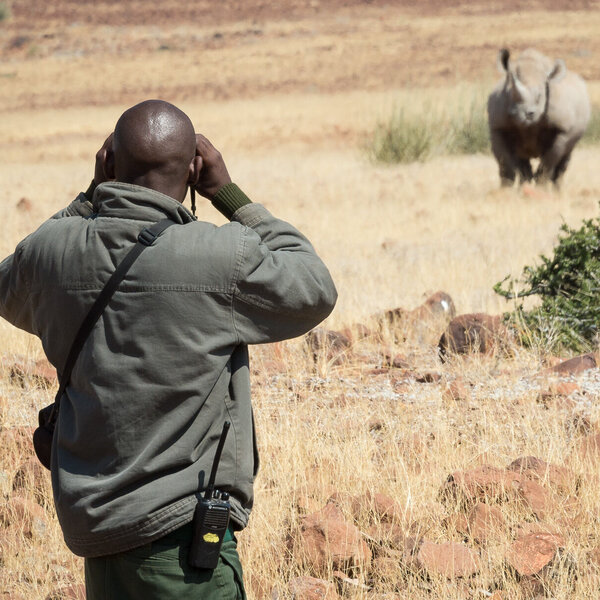
Save the Rhino Trust
Based in the Kunene Region in Namibia's northwest, Save the Rhino Trust Namibia (SRT) is a non-governmental organisation working to protect the area's population of desert-adapted black rhino (Diceros bicornis bicornis) – the only truly free-ranging population in the world. It was founded in 1982 by a group of local conservationists concerned about the decreasing number of rhino due to poaching.
Save the Rhino Trust Namibia (SRT) works closely with Save the Rhino International in the UK, which supports a number of rhino conservation programmes in both Africa and Asia.
Living outside of a fenced protected area, the Kunene's rhinos are considered to be the largest truly free-ranging black rhino population left in the world. These rhino are protected and monitored by staff from SRT, in conjunction with Namibia's Ministry of Environment and Tourism (MET) and local communities. A number of dedicated SRT patrolling and monitoring teams cover the core rhino range area of over 25,000 km22 (6.7 million acres). These teams deter poaching and record valuable data on individual rhino, such as age, sex, rhino horn size and shape, ear notches and condition. This information is shared with MET who maintain the Kunene Black Rhino database – one of the longest-running and most comprehensive databases on black rhino in the world. This data helps to inform biological management decisions on Namibia's black rhino population.
Other SRT activities include assistance to MET during translocation operations of desert-adapted black rhino into their former habitat to establish meta-populations, and to ensure the survival and growth of the species. Collaboration is fundamental to SRT success and part of their effort focuses on building up knowledge, understanding and skills within partner organizations – including communities, tour operators, government and the international community. An incentive-based training programme in certain conservancies provides community game guards with theoretical and practical training as well as field equipment, uniforms and transport – as well as incentive bonuses. A further activity involves presentation of scene-of-the-crime training courses to rhino stakeholders in the area.
Guests at Desert Rhino Camp can enjoy a unique rhino-tracking experience with SRT trackers, leaving camp in a 4x4 vehicle to search for the rhinos, before getting closer on foot – although not too close!
See more great sustainability projects in Namibia
Health & safety
- Malarial protection recommended
- Yes
- Medical care
- Desert Rhino Camp has a medical kit on site. The nearest doctor is in Outjo, but in an emergency guests would be airlifted to Windhoek.
- Dangerous animals
- High Risk
- Security measures
- Because the area is unfenced and because of the potentially dangerous wildlife, guests are escorted to and from their suites after dark by a guide.
There is an air-horn in each suite to attract attention in case of emergency. - Fire safety
- There are fire extinguishers in each suite and in central areas.
Activities
4WD Safari
Birdwatching
Guided walking safari
Private activities
Extras
- Disabled access
- On Request
- Laundry facilities
- Included
- Money
- There is an electronic safe in each suite. Currency exchange is not offered here.
- Accepted payment on location
- The camp accepts payment by Visa or Mastercard as well as cash in Namibian dollars and South African rand.
Other lodges in Damaraland
Alternative places to stay in this same area.
